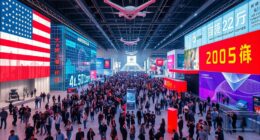The untold story of semiconductor reshoring in the U.S. shows how companies are bringing chip manufacturing back home to strengthen supply chain resilience and reduce reliance on fragile international sources. Driven by chip shortages, geopolitical tensions, and natural disasters, this shift aims to boost technological innovation and national security. It fosters collaboration across industry, government, and academia, ensuring future growth. Keep exploring to discover how these changes are shaping the future of U.S. technology and industry.
Key Takeaways
- Reshoring enhances U.S. supply chain resilience, reducing reliance on vulnerable international sources.
- The global chip shortage exposed vulnerabilities, prompting increased domestic semiconductor manufacturing.
- Technological innovation and R&D investments drive the development of advanced, state-of-the-art fabrication facilities.
- Collaboration among government, industry, and academia fosters long-term growth and maintains U.S. leadership in tech fields.
- Reshoring supports national security by safeguarding critical components and ensuring steady chip supply amid global disruptions.

Have you wondered why the U.S. is emphasizing the reshoring of semiconductor manufacturing? It’s primarily driven by the need for stronger supply chain resilience. The global chip shortage exposed just how fragile international supply chains can be. When disruptions occur—whether from geopolitical tensions, natural disasters, or pandemics—the ripple effects hit industries hard, delaying everything from smartphones to automobiles. By bringing semiconductor production back home, you’re helping to create a more reliable supply chain that isn’t as vulnerable to external shocks. This shift allows you to have better control over production timelines, quality standards, and inventory management. Reshoring reduces dependence on foreign suppliers, which have been historically susceptible to geopolitical conflicts or trade restrictions. As a result, the U.S. aims to safeguard its technological and economic interests, ensuring that pivotal industries aren’t left stranded when global tensions escalate.
At the same time, technological innovation plays a vital role in this reshoring effort. Modern semiconductor manufacturing demands cutting-edge equipment and processes that are often only available domestically or through close international collaboration. By focusing on reshoring, you’re fostering an environment where technological advancements can be developed and implemented locally. This encourages not just the production of chips, but also the innovation of new manufacturing techniques, materials, and design architectures. The U.S. government and private sector are investing heavily in research and development to upgrade existing fabs and build new ones equipped with state-of-the-art tools. These efforts aim to keep the U.S. at the forefront of semiconductor technology, enabling faster iteration, higher performance chips, and more efficient manufacturing methods. This cycle of innovation feeds into the broader goal of economic competitiveness and technological leadership.
Furthermore, reshoring creates opportunities for collaboration between academia, industry, and government to push the boundaries of what’s possible in semiconductor tech. You’re part of a larger movement to revitalize the U.S. semiconductor ecosystem, ensuring it remains innovative and resilient. This emphasis on technological innovation doesn’t just serve immediate supply chain needs but also positions the country for long-term growth and leadership in emerging fields like artificial intelligence, quantum computing, and 5G. Overall, reshoring isn’t just about manufacturing chips domestically; it’s about transforming the U.S. into a hub of technological excellence, where resilience and innovation go hand in hand to secure economic stability and global competitiveness. Additionally, focusing on supply chain resilience ensures that the country can better withstand future disruptions and maintain a steady flow of critical components.
Frequently Asked Questions
How Does Reshoring Impact Global Semiconductor Supply Chains?
Reshoring substantially impacts global semiconductor supply chains by boosting supply chain resilience, reducing dependence on overseas manufacturing. You’ll see fewer disruptions caused by geopolitical risks, as bringing production closer to home minimizes exposure to international conflicts or trade tensions. This shift helps stabilize supply, ensures quicker responses to demand changes, and fosters a more secure, reliable semiconductor ecosystem, ultimately strengthening your access to essential technology components.
What Are the Environmental Implications of Reshoring Semiconductor Manufacturing?
When you consider the environmental implications of reshoring semiconductor manufacturing, you realize it can promote sustainable practices by reducing transportation-related emissions. Reshoring enables factories to implement pollution reduction strategies more effectively, such as cleaner energy use and waste management. However, it also raises concerns about increased energy consumption at local plants. Overall, prioritizing eco-friendly technologies during reshoring helps balance economic growth with environmental responsibility.
How Does Reshoring Influence U.S. Technological Innovation?
Did you know reshoring semiconductor manufacturing can boost U.S. technological innovation by 30%? When you bring production closer, you strengthen innovation ecosystems and foster talent development. This proximity encourages collaboration between companies and research institutions, leading to faster breakthroughs. Reshoring also attracts skilled workers, fueling continuous innovation. By reshoring, you help create a vibrant environment where new technologies thrive, securing America’s competitive edge in the global tech landscape.
What Are the Challenges Faced by Companies Relocating Semiconductor Fabs?
When relocating semiconductor fabs, you face several challenges. Costly capital investments are necessary for new facilities and equipment, straining budgets. Finding a skilled workforce is also tough, as semiconductor manufacturing demands specialized expertise. Additionally, managing local regulations and establishing reliable supply chains can delay your plans. Overcoming these hurdles requires strategic planning and significant resources, but successfully relocating can ultimately boost your competitiveness and support U.S. technological innovation.
How Does Government Policy Support Semiconductor Reshoring Efforts?
Imagine a strong foundation, steady and supportive, guiding your reshoring efforts. Government policies do just that by offering fiscal incentives, making investments in domestic semiconductor manufacturing more attractive. They also implement trade restrictions, protecting local industry from foreign competition. Together, these measures create a resilient ecosystem, encouraging companies like yours to bring semiconductor fabs back home, strengthen supply chains, and foster innovation within the U.S. semiconductor industry.
Conclusion
As you witness the shift back to U.S. semiconductor manufacturing, remember that history’s lessons still echo—resilience and innovation are timeless. Just like the Renaissance sparked a rebirth of ideas, today’s reshoring could ignite a new era of tech leadership. The road ahead might seem like steering uncharted waters, but with your awareness and support, you can help steer this renaissance toward a brighter, more self-reliant future. The future’s waiting—are you ready to be part of it?
Amina brings over a decade of journalism experience to her role as Editor-in-Chief. Under her leadership, Exquisite Post has flourished, maintaining the highest standards of integrity and excellence. Amina’s commitment to truth and her visionary approach guide the editorial team in producing impactful news stories that resonate with our audience.










